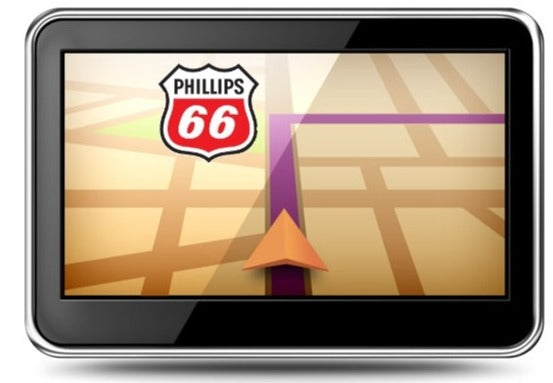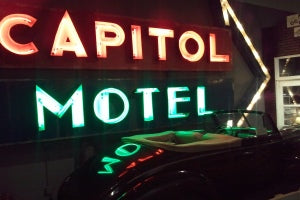Recent Post
Route 66 | Day 1
Aug 29, 2023

Andy Wegener
Mar 15, 2023
Route 66 - The Rubik’s Cube of Motorcycle Tours
Riding the historic Route 66 without professional help is like trying to solve a Rubik's cube blindfolded - challenging and requires some serious skills. With its confusing turns and lack of clear signage it's easy to get lost in the journey, racking up many miles in detours and return trips, feeling more stranded than Tom Hanks in Cast Away.

Some Route 66 History
Ah, Route 66, that most fabled of American highways, stretching like a ribbon of adventure from the industrious East to the sun-kissed West. It's a journey that has captured the hearts of millions, each eager to traverse the "Main Street of America" and sample a taste of its challenge and charm.
Now, let us tell you — Route 66 isn't quite the unbroken thread it once was. The relentless march of progress, in the form of interstate highways, has seen to that. But don't be disheartened, our intrepid travelers, for the spirit of this storied road lives on in the segments that have managed to survive the passage of time.
So, as you embark on this great American expedition, be prepared for a few detours and diversions, as you'll occasionally find yourself nudged onto alternate routes or the odd interstate. But isn't that what travel is all about? Embracing the unexpected and adapting to the road ahead? After all, it's the journey that counts, and Route 66 is nothing if not a journey to remember.

Picture the year 1939—America, the land of dreams, decided to take a bold step and stitch together two of its most illustrious cities, Chicago and Los Angeles, with a ribbon of tarmac that stretched over 2,000 miles. This unassuming stretch of road, baptized as Route 66, would soon become the "Main Street of America," a symbol of freedom and a beacon of hope for Dust Bowl-weary farmers seeking a fresh start.
As the years sauntered by, Route 66 underwent a series of nips and tucks, with its path altered here and there to bypass bustling city centers and escape the clamor of urban traffic. Most famously, the road's terminus was shifted from the heart of downtown Los Angeles to the breezier climes of Santa Monica. However, much like Icarus, Route 66's lofty ambitions would ultimately lead to its undoing.
In 1956, a pivotal moment in American history unfolded as President Eisenhower signed the Interstate Highway Act. This significant act was set to revolutionize the landscape of American travel. Drawing inspiration from the highly efficient German Autobahn, Eisenhower sought to create a more streamlined network connecting cities across the nation. This vision led to a profound transformation, and on June 27, 1985, Route 66, once the lifeline of American road travel, was unceremoniously decommissioned. In its place emerged a sprawling web of modern interstates, marking a new era in the nation's journey toward progress and connectivity.
But, as is often the case with American legends, Route 66 refused to fade quietly into the sunset. In the 1990s, a glimmer of hope appeared when Route 66 associations sprouted up in Arizona and Missouri, determined to preserve the memory of this once-great highway. Other states soon followed suit, and before long, "Historic Route 66" began cropping up on maps like a phoenix rising from the ashes. With a wink and a nod, the iconic road seemed to say, "I'm still here, and I'm alive and kicking!"
🎶

Over 100 Route 66 Tours…
Boasting over 100 tours under our belt - formerly as California Sunriders - we're not your ordinary tour company. Oh no, we've had the keys to the kingdom - or at least the key to the Old Chain of Rocks Bridge, which made us the only tour operator cruising across this legendary landmark.
We're so intimately acquainted with the Mother Road, we could write a rom-com about it. Our pals, who happen to be Route 66 locals and business operators from the good ol' days, have dished the dirt on all things Route 66. And now, we're passing that juicy gossip - er, valuable knowledge - onto you.
So buckle up, buttercup! We're serving up Route 66's ins and outs on a silver platter, seasoned with wit and charm. Get ready for a memorable joyride that's streets ahead of any other tour experience you've ever had.
Imagine: You're hankering for a full-throttle romp down the fabled Route 66, giving a wide berth to the humdrum interstates and freeways that crisscross America. You want to feast your eyes on vintage diners and immerse yourself in a bygone era, channeling the ghosts of Kerouac and Steinbeck as you traverse a landscape where road trips quenched the thirst of wander-lusting souls in search of themselves—and whatever other hidden gems lay just beyond the horizon.
Well, you came this far to find our site. We're your personal treasure trove of Route 66 know-how, amassed over a whopping 25 years of tire-kicking and tarmac-traversing. We're here to hand over the keys to your very own Route 66 odyssey, transforming your dreams of yesteryear into a Technicolor reality. Trust us — we've been in the rider’s (and driver's) seat for a quarter of a century!
Where is Route 66?
Route 66, often hailed as America's Main Street, is the road trip dream woven into the fabric of the U.S. Starting in the Windy City of Chicago, Illinois, it stretches its asphalt limbs all the way to the sunny shores of Santa Monica, California.
This iconic highway, spanning a whopping 2,448 miles, meanders through eight states - a list that reads like a roll call for America's heartland: Illinois, Missouri, Kansas, Oklahoma, Texas, New Mexico, Arizona, and finally, California.
Established in 1926, Route 66 was more than just a road; it was the corridor of dreams for many, especially during the Dust Bowl era. It's where the American spirit of adventure got its wheels, quite literally. But don't let the history books fool you; this old road still has plenty of kicks left in it.
Though officially decommissioned and overshadowed by the Interstate System (which is like Route 66's less charismatic younger sibling), the Mother Road refuses to retire. Today, it's a nostalgic journey through Americana, peppered with retro diners, quirky roadside attractions, and a sense of humor about its ripe old age. It's the road that just keeps on giving, one historic marker at a time!
Note that many U.S. states have a Route 66 or Highway 66. However, these might be state routes, so when we're stating historic U.S. Route 66, we refer only to this iconic route, running from Chicago to California.

How Much Time Do I Need?
If you're planning a trip on Route 66, we recommend taking at least two weeks to enjoy the journey, but if you can swing it, a full month would be even better. Of course, not everyone can take a month-long vacation, so we've based our itinerary on the assumption that most travelers will have two weeks to spare. The duration of our approved Route 66 Tour is 15 days including arrival and departure day and a recommended spare day in Williams, AZ.
If you follow our recommended route, the average riding time will be around four or five hours a day, so you have plenty of time to explore the attractions, take photos, go on walking tours, and grab some grub.
Keep in mind that this estimate doesn't account for any detours or alternate routes you might take, so you may want to budget some extra time.
Once you have an idea of how much time you'll be spending on the road each day, you can start planning your stops and figuring out where to spend the night. Don't forget to factor in time for restroom breaks, food stops, and other unplanned diversions along the way.
We Must Admit…
Even our itinerary will lead you onto the interstate - for two good reasons: a) some sections of Interstate 40 have been paved directly on top of the old 66 alignment; and b) if we suggest you take the interstate it’s because the old route is so severely damaged that it’s only manageable with a heavy-duty 4-wheel drive.
Where Do I Stay?
Our selection of accommodations achieves a perfect harmony, meticulously blending comfort, ideal locations, safety, and authenticity. Leveraging our extensive experience journeying along Route 66, we have handpicked hotels and motels that offer more than just a place to rest your head. They encapsulate the true essence of the Mother Road. Intriguingly, for half of our recommended stops, our preferred options align with the timeless, classic lodging choices of Route 66. This blend of traditional charm and modern convenience ensures an unforgettable experience on this legendary highway.
More detailed information can be found in our article "Historic Route 66 Hotels & Motels: Where to Stay on Route 66".

What's There to See??
In a nutshell: neon signs, old motels, old gas stations, classic cars, great museums, iconic bridges, some major metropolises, giants, diners, small and big rivers, jail cells, and about 2500 miles of pre and post-1930 asphalt.
But not so fast!
As you traverse through eight diverse states, you'll experience a rich tapestry of environments - from the arid stretches of desert to the majestic mountains, from sprawling farmlands to bustling metropolises and quaint small towns.
These towns, especially, are where the heart of Route 66 beats strongest, embodying the quintessential image of Small Town America.
While the cities on Route 66 offer their unique charm, the smaller towns often steal the show. Strolling down their Main Streets, you might find the day's adventure in the simple joys of a classic diner meal, a walk past historic buildings, or even a visit to an old steam engine.
On Route 66, the journey itself is the destination. The road was built for travel from Point A to Point B, but today, it's the road itself that calls to adventurers.
Iconic sights pepper the route: neon signs of roadside cafes, vintage motels, old-school gas stations, and tourist traps that harken back to the 1950s. Many of these original establishments remain, inviting you to step back in time and dine, sleep, or explore just as travelers did in Route 66's heyday.
A Route 66 road trip is marked by simple pleasures – enjoying a hamburger and ice cream soda at a classic diner, discovering a quirky tourist attraction, and resting at a family-run motel. Yet, there's a tinge of nostalgia in the air, as many businesses that once thrived on Route 66's traffic have faded away, leaving behind haunting yet fascinating relics like ruined buildings and ghost towns.
The natural beauty along the route is breathtaking, from the Mojave and Painted Deserts to the Petrified Forest and the mighty Mississippi River. And if you're willing to venture off the beaten path, wonders like the Grand Canyon await.
But it's not just nature that will catch your eye. The route is dotted with quirky art installations, giant statues (think giant blue whales, dinosaurs, and even the world's largest rocking chair), restored gas stations, and drive-in movie theaters. Murals, Old West shows, historical railroad attractions, and a plethora of museums add layers of cultural richness to the journey.
These roadside attractions are more than just photo opportunities; they are the guardians of stories, the landmarks of an era. Highlights like the Muffler Men, the world’s largest concrete totem pole, and the giant soda bottle are not just fun pit stops but symbols of a time when the journey was as celebrated as the destination.
As you drive this historic route, you’re not just traveling through states; you’re journeying through history, culture, and a legacy of American travel. Every mile on Route 66 brings a new discovery, a different perspective, and a deeper appreciation for the road that helped shape the nation.
Route 66 is not just a road; it's a journey through the heart of America. It's where nostalgia meets discovery, where the past greets the present, and where every traveler finds their own story. Whether it's through its natural wonders, its historic landmarks, or its quirky roadside attractions, Route 66 promises an adventure that's as timeless as the road itself.
When Should I Travel?
Indeed, the ideal time to embark on a Route 66 adventure is whenever you can make the journey. The beauty of Route 66 lies in its timeless appeal, ready to be explored whenever you are. However, if you find yourself planning a trip during a less conventional time of the year, the key is to be well-prepared and adaptable.
Route 66, with its vast stretch across eight diverse states, is a mosaic of climates and temperatures. From the windy streets of Chicago to the sun-drenched beaches of Santa Monica, the weather can be as varied as the landscapes you'll traverse. This means packing for all possibilities and being ready for sudden changes in weather as you journey through different regions.
But hey, remember we're on motorcycles? Your time frame here is May through October, with moderate climate in May, first half of June, and October. July and August can get very humid in the midwest and oven-like toasty in the desert out west.
Please don't nail us down for it. We only have this little frog climbing up and down a ladder, and while our amphibious friend might not provide the most accurate weather updates, embarking on a Route 66 adventure with this light-hearted spirit is part of the journey's joy. It's a reminder that sometimes the best travel experiences come with a touch of unpredictability and a good dose of humor.

Need to Rent Your Ride?
Unless you're riding your own bike for this tour you're gonna need a rental motorcycle. Our recommended motorcycle rental company is Explorify who offer one-way rentals between Chicago and Los Angeles and vice versa. Explorify is the second-largest motorcycle rental company in the U.S. with locations in Chicago, Los Angeles, New Orleans, Las Vegas, and Orlando - still growing and expanding.
Prices are very competitive compared to other rental companies, and Explorify offers price match with any other comparable rental offer. You can choose between Harley-Davidson®, Indian®, Triumph®, BMW®, KTM® and Honda®
Their customer service is second to none and the rental location inside Chicago Harley-Davidson is operated very efficiently, professionally, and friendly. The staff is getting you on your preferred iron steed in the shortest amount of time. If you pre-pay optional insurance, pre-complete personal data forms, and send copies of your driver's license, you'll be on the road in no time.
Speaking of driver's licenses - the requirements are: minimum age of 21 and a valid motorcycle endorsement, that's it! No international driver's license is necessary unless your endorsement is issued in a language other than English.
If you don't bring your own lid, helmets are available in limited numbers. We always recommend bringing your own helmet for comfort and safety reasons.

What do I Pack?
Embarking on a 13-day motorcycle adventure? That's the spirit! But with the open road ahead and limited space in your saddlebags, packing smart and light is key to a carefree journey.
The larger touring class bikes will have saddlebags, top case, and most likely a luggage rack on the top case lid for additional lightweight baggage.
While the question “What to pack?” seems to sound rather redundant, still, here's your fun-size packing list for a wildly memorable ride:
1. The Essentials:
- Lightweight, layered clothing: Mix and match to the max! Think quick-dry shirts, a couple of tees, a long-sleeve shirt (for those chilly mornings), and a pair of versatile pants.
- Waterproof gear: Because you can't trust the weatherman, and a little rain shouldn't rain on your parade.
- A compact, all-weather motorcycle jacket:
- and pants set - your stylish armor against the elements.
- Undergarments and socks: Pack enough for a week; you can always find a place to do a quick wash.
- A compact, quick-dry towel: Because sometimes you gotta dry off on the fly!
2. Safety First:
- Helmet: Your trusty noggin protector (bonus points for a built-in visor).
- Gloves: To keep those hands comfy and in control.
- Sturdy boots: Protect your feet and stay road-ready.
- Earplugs: To keep the wind's roar at a bearable decibel.
3. Road Life Essentials:
- A travel-sized toiletry kit: Keep it light - all the basics in miniature form.
- Basic first-aid kit: For those just-in-case moments.
- Pocket multi-tool: Like a portable toolbox (but cooler).
4. Tech and Entertainment:
- Smartphone and charger: For navigation, tunes, and those #RoadTrip selfies.
- Portable power bank: Keep your gadgets juiced up.
- A small notebook and pen: For scribbling down thoughts or directions.
5. On the Road Snacks and Hydration:
- Reusable water bottle: Stay hydrated, my friend.
- Easy-to-pack snacks: Think nuts, energy bars, and dried fruits.
6. Miscellaneous Magic:
- Sunglasses: Ride in style while protecting your eyes.
- Sunscreen: Because the sun doesn't play nice.
- EZ Route 66 Guide for Travelers: Old-school but gold.
- A lightweight backpack: For those off-bike explorations.
7. Just-for-Fun:
- A harmonica or travel-sized instrument: Unleash your inner road musician.
- A deck of cards: For those nights around the campfire.
Remember, every item is a precious cargo on your two-wheeled steed, so pack items that serve multiple purposes, can be layered, or easily compressed. Enjoy the freedom, embrace the adventure, and let the road be your guide!
Best suited for a long trip are the ultra touring class motorcycles. They offer saddlebags, top case (often with additional luggage rack), and additional storage for small items in the front. This should get two-up riders through a 2-week trip just fine.
If you happen to travel by yourself you'll have even more space on the passenger seat for an additional tour pack. Tour packs are also suitable for those bikes that come with a passenger backrest (sissy bar) as they can be tied to the rack easily.
We recommend brand-specific inserts for the saddlebags and top case; they make it a lot easier to load and unload your bike.

How Much Money do I Need?
Always bring loads! Just kidding!! To estimate the cost of accommodation, fuel, and food for this 13-day motorcycle trip, you need to consider several factors:
1. Accommodation Costs: Prices vary greatly depending on the type of accommodation you choose. Options range from budget hotels and motels, to more expensive inns or boutique hotels.
2. Fuel Costs: The cost of fuel depends on the fuel efficiency of your motorcycle and the current fuel prices. You'll need to estimate the total distance of your trip and divide it by your motorcycle's miles per gallon (MPG) to estimate the total gallons of fuel you'll need. Then multiply by the current price per gallon.
3. Food Costs: This can vary based on your eating habits. If you plan to eat mostly in low-key diners or prefer fine dining restaurants wherever available, your cost will vary greatly.
Let's do a rough estimate with some assumptions:
- Accommodation: $170 per night
- Fuel: 45 MPG average for the motorcycle, 2500 miles total trip, and $4 per gallon for fuel
- Food: $70/person / per day for a mix of regular and fine dining
Let's calculate the estimated costs based on these assumptions.
Based on the assumptions made, here's a rough estimate of the costs for a 13-day motorcycle trip for two people:
1. Accommodation Costs:
- Total for staying in hotels: $2,340 (assuming the room cost remains the same for one or two occupants)
2. Fuel Costs:
- Total estimated fuel cost: $222.22 (for 2,500 miles at 45 MPG and $4 per gallon)
3. Food Costs (for two people):
- Estimated: $1,820
Therefore, the total estimated cost for the trip, considering two people, is: $4,382.00
Now you have to add the cost of travel expenses to get to Chicago (e.g. flights) and/or the cost of a rental motorcycle, if applicable.
These estimates are based on the assumption that the cost of a hotel room remains the same whether it's for one or two people. Also, the fuel cost is calculated per motorcycle. As with any trip, it's advisable to include a buffer in your budget for any unexpected expenses.
Please note, that these are approximate values and actual costs can vary based on various factors like changes in fuel prices, personal preferences, and unplanned expenses. It's always a good idea to have a buffer in your budget for unexpected costs.

Itinerary Shortcuts - jump right to where you want to be.
Chicago |
► |
Springfield |
|
Springfield |
► |
St. Louis |
|
St. Louis |
► |
Springfield |
|
Springfield |
► |
Tulsa |
|
Tulsa |
► |
Weatherford |
|
Weatherford |
► |
Amarillo |
|
Amarillo |
► |
Santa Fe |
|
Santa Fe |
► |
Gallup |
|
Gallup |
► |
Winslow |
|
Winslow |
► |
Williams |
|
Williams |
► |
Needles |
|
Needles |
► |
Victorville |
|
Victorville |
► |
Santa Monica |
← Older Post Newer Post →







